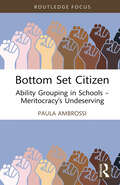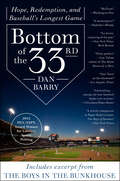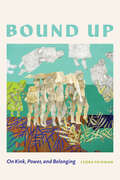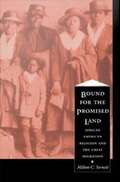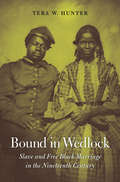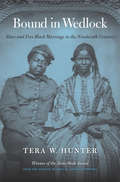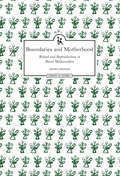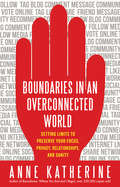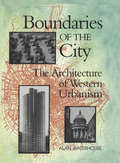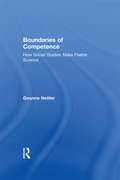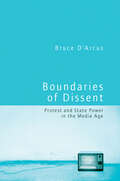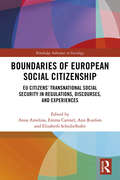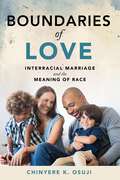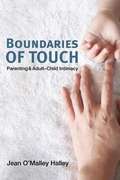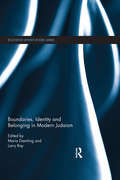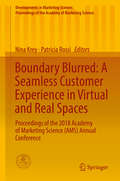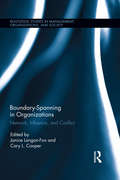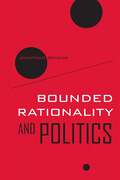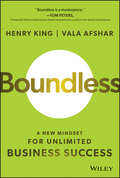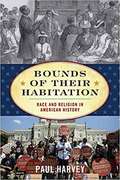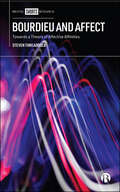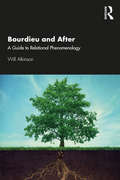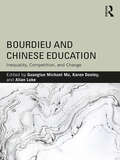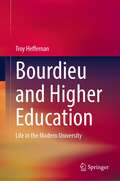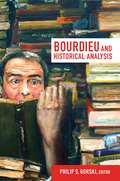- Table View
- List View
Bottom Set Citizen: Ability Grouping in Schools – Meritocracy’s Undeserving (Routledge Advances in Sociology)
by Paula AmbrossiWhile research evidence shows the negative impact of ability grouping on children, this book suggests that the reason the practice is still embraced is the unspoken allegiance to the values of empire that governments, schools, and many parents still uphold, promoting competition and hierarchies over and above ethical principles on the education of society’s most vulnerable, our children.The practice, which happens across social class, humiliates children deemed ‘less academically able’ by ‘rounding them up’ in front and in opposition to their ‘better’ intellectual peers. Wielding knowledge as a weapon of humiliation warps children’s relationship to organized forms of knowledge, making them antagonistic or indifferent towards it. This book responds to Michael Young’s The Rise of the Meritocracy, by focusing on the plight of those who are educationally placed in opposition to the ‘intellectual elites’: the bottom set citizen, rich or poor and ready to vote.This book will appeal to anyone concerned with democracy and children’s rights in education, including the rich, on whom I shine the light of deficit for a change. Thus, Donald Trump and Nigel Farage exemplify the bottom set citizen in all his facilitated glory. Other, more vulnerable BSCs are not as lucky.
Bottom of the 33rd: Hope and Redemption in Baseball's Longest Game
by Dan BarryIn “a worthy companion to . . . Boys of Summer,” a Pulitzer prize winning journalist “exploits the power of memory and nostalgia with literary grace” (New York Times).From award-winning New York Times columnist Dan Barry comes the beautifully recounted story of the longest game in baseball history—a tale celebrating not only the robust intensity of baseball, but the aspirational ideal epitomized by the hard-fighting players of the minor leagues.On April 18, 1981, a ball game sprang eternal. For eight hours, the night seemed to suspend a town and two teams between their collective pasts and futures, between their collective sorrows and joys—the shivering fans; their wives at home; the umpires; the batboys approaching manhood; the ejected manager, peering through a hole in the backstop; the sportswriters and broadcasters; and the players themselves—two destined for the Hall of Fame (Cal Ripken and Wade Boggs), the few to play only briefly or forgettably in the big leagues, and the many stuck in minor-league purgatory, duty bound and loyal forever to the game.With Bottom of the 33rd, Barry delivers a lyrical meditation on small-town lives, minor-league dreams, and the elements of time and community that conspired one fateful night to produce a baseball game seemingly without end. An unforgettable portrait of ambition and endurance, Bottom of the 33rd is the rare sports book that changes the way we perceive America’s pastime—and America’s past.“Destined to take its place among the classics of baseball literature.” —Kirkus Reviews (starred review)“Bottom of the 33rd is chaw-chewing, sunflower-spitting, pine tar proof that too much baseball is never enough.” —Jane Leavy, author of The Last Boy and Sandy Koufax
Bound Up: On Kink, Power, and Belonging
by Leora FridmanA provocative look at historical trauma as bound, incarnated, and processed through intimate and sexual expression. In an autotheoretical journey through bondage, domination, and intimacy, Leora Fridman uncovers how Jewish historical trauma can be challenged and explored in embodied relations. Drawing on her experiences as an American Jew in Germany, Fridman delves into BDSM practices and experimental communities from Oakland to Berlin. This work weaves personal encounters with critical analysis founded in feminist theory, queer literature, Holocaust history, and memory studies. Bound Up begins with kink and leads us through a sensual and intelligent approach to intergenerational trauma and lived politics. What kind of healing can take place in the relational and physical realm? How can intimacy contradict and complement the process of political reparations? Fridman layers a nuanced understanding of shame, responsibility, and power with explorations of cinema, contemporary art, and popular culture to shed light on topics from personal and political relationships to victimhood and blame. Both timely and timeless, this work is an address to history and the contemporary moment, relevant to Jews, diasporic scholars, and all exploring ethical relationships with history and with other humans.
Bound for the Promised Land: African American Religion and the Great Migration
by Milton C. SernettBound for the Promised Land is the first extensive examination of the impact on the American religious landscape of the Great Migration--the movement from South to North and from country to city by hundreds of thousands of African Americans following World War I. In focusing on this phenomenon's religious and cultural implications, Milton C. Sernett breaks with traditional patterns of historiography that analyze the migration in terms of socioeconomic considerations. Drawing on a range of sources--interviews, government documents, church periodicals, books, pamphlets, and articles--Sernett shows how the mass migration created an institutional crisis for black religious leaders. He describes the creative tensions that resulted when the southern migrants who saw their exodus as the Second Emancipation brought their religious beliefs and practices into northern cities such as Chicago, and traces the resulting emergence of the belief that black churches ought to be more than places for "praying and preaching. " Explaining how this social gospel perspective came to dominate many of the classic studies of African American religion, Bound for the Promised Land sheds new light on various components of the development of black religion, including philanthropic endeavors to "modernize" the southern black rural church. In providing a balanced and holistic understanding of black religion in post-World War I America, Bound for the Promised Land serves to reveal the challenges presently confronting this vital component of America's religious mosaic.
Bound in Wedlock: Slave and Free Black Marriage in the Nineteenth Century
by Tera W. HunterTera W. Hunter offers the first comprehensive history of African American marriage in the nineteenth century and into the Jim Crow era. She reveals the practical ways couples adopted, adapted, or rejected white Christian ideas of marriage, creatively setting their own standards for conjugal relationships under conditions of uncertainty and cruelty.
Bound in Wedlock: Slave and Free Black Marriage in the Nineteenth Century
by Tera W. HunterTera W. Hunter offers the first comprehensive history of African American marriage in the nineteenth century and into the Jim Crow era. She reveals the practical ways couples adopted, adapted, or rejected white Christian ideas of marriage, creatively setting their own standards for conjugal relationships under conditions of uncertainty and cruelty.
Boundaries and Motherhood: Ritual and Reproduction in Rural Maharashtra
by Deepra DandekarThis book links caste and gender to the social production of motherhood. The author argues that in contradiction to the assumption that motherhood is a primarily female-centred and positive domain, subaltern agency produces it as malign, dangerous, malevolent and marginal. Highlighting the manner in which the experience and expression of motherhood is constructed as androgynous and non-threatening to patriarchal hegemony, the author emphasizes the consolidation of 'lower' caste positive identity through valorization processes and shows how high caste and class ownership and power produce the birth and survival of a male child as their ideological validaton. Little has been written about the experiences of motherhood in India. Much research has focussed on maternal mortality/morbidity and child morbidity/mortality as elements that inform public health statistical concerns. Here, the author reinvents and deconstructs existing notions of maternity by interrogating the very systemic and patriarchal nature of its language that depoliticizes oppression.
Boundaries in an Overconnected World
by Anne KatherineOver the past decade, 24/7 connectivity has given us not only convenience and fun but worries about privacy, interruptions while working or trying to enjoy family or other downtime, and new compulsions -- from shopping to tweeting and cute-cat watching. Anne Katherine, one of the authors who brought boundary setting to a mass audience, has now written a book on how to set healthy boundaries with technology. The first of its kind, this resource doesn't suggest anyone go "cold turkey." Instead, it helps people make social media, smart phones, and other innovations work for, rather than against, them. Readers learn to protect themselves online in every way -- from predators and data mining as well as time-devouring friends and acquaintances -- with an emphasis on preserving and optimizing meaningful personal connections. Anyone who has ever wondered if their cute little gadget was actually an enemy invader will welcome Katherine's strategies for ensuring "that your life is truly your own."
Boundaries of the City
by Alan WaterhouseIn this study Alan Waterhouse draws on anthropological, social and cultural history, literature, and philosophy to reach an understanding of the roots of Western architecture and city building. He explores the illusion that cities are constructed to impose rational order, an order articulated through urban boundaries. These boundaries, he finds, are shaped around our instinctive fears and insecurities about crime, insurrection, and the violent disruption of everyday life. At the same time, contrary instincts aspire to create a unified domain, to proclaim the interdependence of things through constructed work. Cities are shaped less by rational design than by a recurring dialectic of boundary formation.These impulses underlie the formal vocabulary of architecture and urbanism. Waterhouse follows them through the theories, ideologies, and styles that seem to govern city buildings; he finds their presence in the creation of territorial divisions, and also wherever the cityscape has been shaped by a poetic imagination.Tracing his narrative of urban boundaries from antiquity to the birth of modernism, Waterhouse discovers some stubborn legacies that bind contemporary urban design to the past. Part One explores the boundary dialectic in our regard for deities, for nature, and for one another, and then as a powerful influence on architectural invention and our ways of life. Part Two traces these themes through city building history, to show how architecture and human relatedness are subordinated by boundary formation in the cycles of urbanization. Disclaimer: Image 6.5 removed at the request of the rights holder.
Boundaries of Competence: Knowing the Social with Science
by Gwynne Nettler"The term ""social science"" promises more than its practitioners can deliver: it promises knowledge. This knowledge is to consist of statements of empirical regularities of such quality as will enhance predictive power and inform public and private policy. Boundaries of Competence illuminates obstacles to this aspiration.Chapter 1 grounds knowledge in perception. Chapter 2 challenges the assumption that ordinary language necessarily describes reality and reveals the mischief words can do. Chapter 3 proposes a continuum of perceiving-conceiving involved in different ways of ""knowing"" worlds. Chapter 4 lays out requirements of measurement, arguing that assigning numbers to dubious observations gives false assurance that mathematical manipulations necessarily rep- resent events.Chapter 5 shows how choice of unit affects the correlations we find in our search for causes. Chapter 6 holds that, given deficiencies in knowledge and perhaps because of the way Nature works, we assess probabilities rather than seek certainties. Chapter 7 notes difficulties in counting events that consist of ""social facts,"" which ""depend on us,"" and those that refer to ""brute facts,"" that exist independently of us. Chapter 8 criticizes the practice of employing proxies for observations of what we're talking about. In particular, it demonstrates the error produced by relying on what people say as measure of what they do.Chapter 9 criticizes ways of explaining conduct by characterizing actors and their acts, and by ""understanding"" them through empathy. Chapter 10 discusses the important and never-ending quarrel about causation. Chapters 11 and 12 argue that in social affairs, decision is regularly torn between doing what is effective (rational) and doing what is right (moral).Nettler's writing is crisp, and his argument balanced. He employs research from several disciplines to challenge ideologically driven descriptions of our condition and explanations of ou"
Boundaries of Dissent: Protest and State Power in the Media Age
by Bruce D'ArcusBoundaries of Dissent looks at the way that political protest, as it is shaped through the space-time collapsing power of media, questions national identity and state authority. Through this lens of protest politics, Bruce D'Arcus examines how public and private space is symbolically mediated-the way that power and dissent are articulated in the contemporary media.
Boundaries of European Social Citizenship: EU Citizens’ Transnational Social Security in Regulations, Discourses and Experiences (Routledge Advances in Sociology #1)
by Anna Amelina Emma Carmel Ann Runfors Elisabeth ScheibelhoferThis edited collection contributes to studies of intra-EU migration and mobility, welfare, and European social citizenship by focusing on transnational labour movements from new to the old EU member states (Hungary–Austria, Bulgaria–Germany, Poland–UK and Estonia–Sweden). The volume provides a comparative analysis of formal organization and mobile individuals’ use of European social security coordination, which involves mobile Europeans' access to and portability of social security rights from the sending to the receiving country (and back). The book discloses the selectivity criteria of welfare provision in four areas (unemployment, family benefits, health insurance, and pensions) that lay at heart of European cross-border social security governance. It also identifies specific discourses of belonging (gendered, ethnicized/racialized and class-related images of ‘Us’ and ‘Them’) that frame the institutional selectivity by constructing images of mobile EUcitizens' ‘deserving’ or ‘non-deserving’ social membership. The collection offers a detailed examination of inequality experiences mobile EU citizens from the new EU countries encounter while accessing and porting social security rights across borders. It will be of interest to a wide range of social science and interdisciplinary researchers, students, and practitioners as well as those interested in intra-EU migration and mobility, social security, European social citizenship, and transnational studies.
Boundaries of Love: Interracial Marriage and the Meaning of Race
by Chinyere K. OsujiHow interracial couples in Brazil and the US navigate racial boundaries How do people understand and navigate being married to a person of a different race? Based on individual interviews with forty-seven black-white couples in two large, multicultural cities—Los Angeles and Rio de Janeiro—Boundaries of Love explores how partners in these relationships ultimately reproduce, negotiate, and challenge the “us” versus “them” mentality of ethno-racial boundaries.By centering marriage, Chinyere Osuji reveals the family as a primary site for understanding the social construction of race. She challenges the naive but widespread belief that interracial couples and their children provide an antidote to racism in the twenty-first century, instead highlighting the complexities and contradictions of these relationships. Featuring black husbands with white wives as well as black wives with white husbands, Boundaries of Love sheds light on the role of gender in navigating life married to a person of a different color.Osuji compares black-white couples in Brazil and the United States, the two most populous post–slavery societies in the Western hemisphere. These settings, she argues, reveal the impact of contemporary race mixture on racial hierarchies and racial ideologies, both old and new.
Boundaries of Touch: Parenting and Adult-Child Intimacy
by Jean HalleyDiscussing issues of parent-child contact ranging from breastfeeding and sleeping arrangements to sexual abuse, Jean O'Malley Halley traces the evolution of mainstream ideas about touching between adults and children over the course of the twentieth century in the United States. Boundaries of Touch shows how arguments about adult-child touch have been politicized, simplified, and bifurcated into "naturalist" and "behaviorist" viewpoints, thereby sharpening certain binary constructions such as mind/body and male/female. In addition to contemporary periodicals and self-help books on child rearing, Halley uses information gathered from interviews she conducted with mothers ranging in age from twenty-eight to seventy-three. Throughout, she reveals how the parent-child relationship, far from being a private or benign subject, continues as a highly contested, politicized affair of keen public interest.
Boundaries, Identity and belonging in Modern Judaism (Routledge Jewish Studies Series)
by Larry Ray Maria DiemlingThe drawing of boundaries has always been a key part of the Jewish tradition and has served to maintain a distinctive Jewish identity. At the same time, these boundaries have consistently been subject to negotiation, transgression and contestation. The increasing fragmentation of Judaism into competing claims to membership, from Orthodox adherence to secular identities, has brought striking new dimensions to this complex interplay of boundaries and modes of identity and belonging in contemporary Judaism. Boundaries, Identity and Belonging in Modern Judaism addresses these new dimensions, bringing together experts in the field to explore the various and fluid modes of expressing and defining Jewish identity in the modern world. Its interdisciplinary scholarship opens new perspectives on the prominent questions challenging scholars in Jewish Studies. Beyond simply being born Jewish, observance of Judaism has become a lifestyle choice and active assertion. Addressing the demographic changes brought by population mobility and 'marrying out,' as well as the complex relationships between Israel and the Diaspora, this book reveals how these shifting boundaries play out in a global context, where Orthodoxy meets innovative ways of defining and acquiring Jewish identity. This book is essential reading for students and scholars of Jewish Studies, as well as general Religious Studies and those interested in the sociology of belonging and identities.
Boundary Blurred: Proceedings of the 2018 Academy of Marketing Science (AMS) Annual Conference (Developments in Marketing Science: Proceedings of the Academy of Marketing Science)
by Nina Krey Patricia Rossi“We see our customers as invited guests to a party, and we are the hosts. It’s our job every day to make every important aspect of the customer experience a little bit better.” Jeff Bezos, Founder and CEO of Amazon.com This proceedings volume explores the ways in which marketers can learn about customers through big data and other sources to create an enhanced customer experience. Consumers today do not simply demand engaging online or offline experiences anymore; they increasingly focus on one seamless experience throughout their journey across virtual and real spaces. While shopping in a physical store, consumers are checking their smart phones for customer reviews and competitive information, and catching a Pokémon or two at the same time. Online experience is no longer only about price shopping and convenience, and offline is no longer only about SKUs. Individual channels matter less and less; it is the omni-channel experience that is becoming main-stream. Marketers need to keep pace and continually adapt and contribute to the changing consumer landscape. Through countless touchpoints across different channels and media, marketers today can learn more about their customers and are better equipped than ever to provide them with a desired augmented experience: easy, fun, engaging, and efficient. Featuring the full proceedings from the 2018 Academy of Marketing Science (AMS) Annual Conference held in New Orleans, Louisiana, this volume provides ground-breaking research from scholars and practitioner from around the world that will help marketers continue to engage their customers in this new landscape. Founded in 1971, the Academy of Marketing Science is an international organization dedicated to promoting timely explorations of phenomena related to the science of marketing in theory, research, and practice. Among its services to members and the community at large, the Academy offers conferences, congresses, and symposia that attract delegates from around the world. Presentations from these events are published in this Proceedings series, which offers a comprehensive archive of volumes reflecting the evolution of the field. Volumes deliver cutting-edge research and insights, complementing the Academy’s flagship journals, the Journal of the Academy of Marketing Science (JAMS) and AMS Review. Volumes are edited by leading scholars and practitioners across a wide range of subject areas in marketing science.
Boundary-Spanning in Organizations: Network, Influence and Conflict (Routledge Studies in Management, Organizations and Society #26)
by Cary L. Cooper Janice Langan-FoxIn more recent times, the essence of the gatekeeper's role has moved to the 'boundary spanner' - a systems thinker who understands the specific needs and interests of the organization and whose greatest asset is their ability to move across and through the formal and informal features of the modern organization. There are many types of boundaries associated with an organization, for example, horizontal, (function and expertise), vertical (status, hierarchy), geographic, demographic, and stakeholder. Boundaries are "the defining characteristic of organizations and, boundary roles are the link between the environment and the organization" (Aldrich & Herker, 1977) with functions crucial to the effectiveness and success of the organization. Despite being a critical success factor for an organization, beginning in the 1970s, the term - 'boundary spanning' has had an intermittent research history: there has been no systematic body of research that has evolved over time. This book aims to invigorate, excite, and expand the literature on boundary spanning in a diverse range of disciplines such as sociology, organizational psychology, management, medicine, defence, health, social work, and community services. The book serves as the first collection of reviews on boundary spanning in organizations.
Bounded Rationality and Politics (Wildavsky Forum Series #6)
by Jonathan BendorIn Bounded Rationality and Politics, Jonathan Bendor considers two schools of behavioral economics—the first guided by Tversky and Kahneman’s work on heuristics and biases, which focuses on the mistakes people make in judgment and choice; the second as described by Gerd Gigerenzer’s program on fast and frugal heuristics, which emphasizes the effectiveness of simple rules of thumb. Finding each of these radically incomplete, Bendor’s illuminating analysis proposes Herbert Simon’s pathbreaking work on bounded rationality as a way to reconcile the inconsistencies between the two camps. Bendor shows that Simon’s theory turns on the interplay between the cognitive constraints of decision makers and the complexity of their tasks.
Boundless: A New Mindset for Unlimited Business Success
by Henry King Vala AfsharTransform your organization by making silos a thing of the past In Boundless, two leaders in transformation and customer success deliver an inspiring and exciting new approach to succeeding in an increasingly decentralized and digital-first world. In the book, you’ll learn how to demolish organizational silos once and for all, allowing resources to flow across networks, ecosystems, and communities. The authors explain the seven principles underlying their unique and effective “Boundless” paradigm: connection, integration, decentralization, mobility, continuity, autonomy, and shared success. Walking you through the blueprint for transformative, resilient business success, Boundless also offers: Strategies for mapping the Boundless principles to key technological advances, including digital platforms, blockchain, AI, robotics, cloud computing, and more Ways to achieve the operational, organizational, and technological shifts necessary to succeed in an entirely transformed world Tools for combatting the natural tendency of employees to accumulate and protect resources within company silosAn invaluable resource for managers, executives, directors, and other business leaders, Boundless will also earn a place in the libraries of founders, entrepreneurs, and consultants who seek to create an enduring competitive advantage for themselves or their clients.
Bounds Of Their Habitation: Race And Religion In American History (American Ways Series)
by Paul HarveyThere is an “American Way” to religion and race unlike anyplace else in the world, and the rise of religious pluralism in contemporary American (together with the continuing legacy of the racism of the past and misapprehensions in the present) render its understanding crucial. Paul Harvey’s Bounds of Their Habitation, the latest installment in the acclaimed American Ways Series, concisely surveys the evolution and interconnection of race and religion throughout American history. Harvey pierces through the often overly academic treatments afforded these essential topics to accessibly delineate a narrative between our nation’s revolutionary racial and religious beginnings, and our increasingly contested and pluralistic future. Anyone interested in the paths America’s racial and religious histories have traveled, where they’ve most profoundly intersected, and where they will go from here, will thoroughly enjoy this book and find its perspectives and purpose essential for any deeper understanding of the soul of the American nation.
Bourdieu and Affect: Towards a Theory of Affective Affinities
by Steven ThreadgoldSteven Threadgold’s study represents the first comprehensive engagement of Pierre Bourdieu’s influential sociology with affect theory. With empirical research and examples from sociology, it develops a theory of “Affective Affinities,” deepening our understanding of how everyday moments contribute to the construction and remaking of social class and aspects of inequalities. It identifies new ways to consider the strengths and weaknesses of Bourdieusian principles and their interaction with new developments in social theory. This is a stimulating read for students, researchers and academics across studies in youth, education, labour markets, pop culture, media, consumption and taste.
Bourdieu and After: A Guide to Relational Phenomenology
by Will AtkinsonPierre Bourdieu was the most influential sociologist of the late 20th century. The framework he developed continues to inspire countless researchers across the globe and provokes intense debates long after his death. Novel concepts, innovative applications and countless elaborations spring up every day, bulking out and shaping a distinct, if not always entirely consistent, body of work that might be characterised as a recognisable tradition. For those coming to Bourdieu for the first time, therefore, and interested in using his ideas in their own research, it no longer makes sense to confine oneself to the ideas of the man himself. An overview of the varied ways his concepts and arguments have been deepened and updated to make sense of new times or to fill certain gaps, and how insights on seemingly disconnected topics weave together into a bigger picture, is not just desirable but essential. Bourdieu and After aims to provide exactly this overview. Working closely with Bourdieu’s own writings, but also covering a wide range of research and literature inspired by him, it aims to guide the reader through the key principles, the major and minor concepts and the concrete findings of Bourdieusian sociology as clearly and comprehensively as possible. It explains the difficult and often overlooked philosophical foundations, walks through the logic of famous terms like ‘field’, ‘habitus’ and ‘capital’ and demonstrates how they have been or can be used to provide powerful accounts of colonialism, the emergence of nation states and the rise of global social relations. It covers topics that Bourdieu was famous for analysing, like class and educational inequality, yet also traverses subjects on which he said little but that others influenced by him have tackled in depth, such as ethnicity, sexuality and family. Along the way Atkinson seeks to undermine some of the common criticisms levelled at Bourdieu while identifying remaining gaps and limitations. Rather than simply recognising the problems, however, Atkinson proposes possible solutions too – solutions that are facilitated, he argues, by characterising Bourdieusian sociology as what he calls ‘relational phenomenology’.
Bourdieu and Chinese Education: Inequality, Competition, and Change
by Guanglun Michael Mu Allan Luke Karen DooleyThis book uses Bourdieu’s sociological approach for research as a jumping-off point for framing our understandings and analyses of China and Chinese education. Three major themes—inequality, competition, and change—are explored across several theoretical and contextual bases. Bringing together top scholars in the field, the volume examines empirical studies that analyse social (im)mobility through education for students affected by the social divides of class, culture and rural/urban locations; teacher identity and the field of schooling in the current Chinese environment and going forward; and the university as an institution for the production of knowledge about education in the globalising academy. Offering insights into the historical and cultural context for China’s educational landscape, the contributions of this book revisit Bourdieusian concepts from a new empirical vantage point and bring together key studies that illuminate new pathways for the study of Chinese sociology of education.
Bourdieu and Higher Education: Life in the Modern University
by Troy HeffernanThis book introduces Bourdieu in the context of higher education for unfamiliar readers or those who would like to see his theories applied in the higher education setting. It builds upon research into higher education leadership and administration to examine how the university sector has changed over recent decades and how it has been reshaped into its current form.The book draws together various aspects of higher education influenced by the mass-market higher education system to examine how these forces have affected each other positively and negatively and demonstrate the culminating impact of these forces on the sector. It also focuses on the realities of what drives work and life in the modern university. It traces the steps the sector has taken in some areas to address equity issues by increasing diversity and inclusion and highlights the systemic issues that persist.
Bourdieu and Historical Analysis (Politics, history, and culture)
by Philip S. GorskiThe French sociologist Pierre Bourdieu had a broader theoretical agenda than is generally acknowledged. Introducing this innovative collection of essays, Philip S. Gorski argues that Bourdieu's reputation as a theorist of social reproduction is the misleading result of his work's initial reception among Anglophone readers, who focused primarily on his mid-career thought. A broader view of his entire body of work reveals Bourdieu as a theorist of social transformation as well. Gorski maintains that Bourdieu was initially engaged with the question of social transformation and that the question of historical change not only never disappeared from his view, but re-emerged with great force at the end of his career.The contributors to Bourdieu and Historical Analysis explore this expanded understanding of Bourdieu's thought and its potential contributions to analyses of large-scale social change and historical crisis. Their essays offer a primer on his concepts and methods and relate them to alternative approaches, including rational choice, Lacanian psychoanalysis, pragmatism, Latour's actor-network theory, and the "new" sociology of ideas. Several contributors examine Bourdieu's work on literature and sports. Others extend his thinking in new directions, applying it to nationalism and social policy. Taken together, the essays initiate an important conversation about Bourdieu's approach to sociohistorical change.Contributors. Craig Calhoun, Charles Camic, Christophe Charle, Jacques Defrance, Mustafa Emirbayer, Ivan Ermakoff, Gil Eyal, Chad Alan Goldberg, Philip S. Gorski, Robert A. Nye, Erik Schneiderhan, Gisele Shapiro, George Steinmetz, David Swartz
